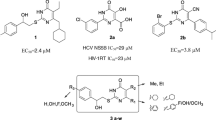Abstract
Fullerenes represent a new molecular form of carbon that is of interest for the unique chemical and physical properties and may be novel lead compounds for drug discovery. However, one of the major issues that prevents the application of fullerenes in the biomedical field is their poor solubility in water, which is related to their high hydrophobic character. To overcome this issue, hydrophilic groups have been incorporated into the fullerene core. These fullerene derivatives possess inhibitory activities against human immunodeficiency virus (HIV) protease, HIV reverse transcriptase protease, HCV NS5B RNA polymerase, and hepatitis C virus (HCV) NS3/4A protease. Therefore, fullerene derivatives may be used as antiviral agents. In addition, some kinds of fullerene derivatives exhibit antiproliferative activities by inducing apoptosis resulting from the generation of reactive oxygen species. In this way, fullerene derivatives have the potential to be new anticancer agents.
Similar content being viewed by others
References
Kroto HW, Heath JR, OʼBrien SC et al (1985) C60: Buckminsterfullerene. Nature 318:162–163
Bingel C (1993) Cyclopropanierung von Fullerenen. Chem Ber 126:1957–1959
Prato M (1997) [60] Fullerene chemistry for materials science applications. J Mater Chem 7:1097–1109
Barre-Sinoussi F, Chermann JC, Rey F et al (1983) Isolation of a T-lymphotropic retrovirus from a patient at risk for acquired immune deficiency syndrome (AIDS). Science 220:868–871
Bartlett JA, Fath MJ, Demasi R et al (2006) An updated systematic overview of triple combination therapy in antiretroviral-naive HIV-infected adults. AIDS 20:2051–2064
Friedman SH, DeCamp DL, Sijbesma RP et al (1993) Inhibition of the HIV-1 protease by fullerene derivatives: model building studies and experimental verification. J Am Chem Soc 115:6506–6509
Friedman SH, Ganapathi PS, Rubin Y et al (1998) Optimizing the binding of fullerene inhibitors of the HIV-1 protease through predicted increases in hydrophobic desolvation. J Med Chem 41:2424–2429
Cohen KA, Hopkins J, Ingraham RH et al (1991) Characterization of the binding site for nevirapine (BI-RG-587), a nonnucleoside inhibitor of human immunodeficiency virus type-1 reverse transcriptase. J Biol Chem 266:14670–14674
Smerdon SJ, Jäger J, Wang J et al (1995) Structure of the binding site for nonnucleoside inhibitors of the reverse transcriptase of human immunodeficiency virus type 1. Proc Natl Acad Sci USA 91:3911–3915
Mashino T, Shimotohno K, Ikegami N et al (2005) Human immunodeficiency virus-reverse transcriptase inhibition and hepatitis C virus RNA-dependent RNA polymerase inhibition activities of fullerene derivatives. Bioorg Med Chem Lett 15:1107–1109
Nakamura S, Ikegami N, Harada M et al (2006) Synthesis of novel amino acid-type fullerenes and their inhibition activity of HIV reverse transcriptase and HCV RNA polymerase. J Kyoritsu Univ Pharm 1:77–84
Nakamura S, Mashino T (2009) Biological activities of water-soluble fullerene derivatives. J Phys Conf Ser 159:012003
Yasuno T, Ohe T, Takahashi K et al (2015) The human immunodeficiency virus-reverse transcriptase inhibition activity of novel pyridine/pyridinium-type fullerene derivatives. Bioorg Med Chem Lett 25:3226–3229
Yang NJ, Hinner MJ (2015) Getting across the cell membrane: an overview for small molecules, peptides, and proteins. Methods Mol Biol 1266:29–53
Kelly TA, Proudfoot JR, McNeil DW et al (1995) Novel non-nucleoside inhibitors of human immunodeficiency virus type 1 reverse transcriptase. 5. 4-Substituted and 2,4-disubstituted analogs of nevirapine. J Med Chem 38:4839–4847
Das K, Clark AD Jr, Lewi PJ et al (2004) Roles of conformational and positional adaptability in structure-based design of TMC125-R165335 (etravirine) and related non-nucleoside reverse transcriptase inhibitors that are highly potent and effective against wild-type and drug-resistant HIV-1 variants. J Med Chem 47:2550–2560
Choo QL, Kuo G, Weiner AJ et al (1989) Isolation of a cDNA clone derived from a blood-borne non-A, non-B viral hepatitis genome. Science 244:359–362
Götte M, Feld JJ (2016) Direct-acting antiviral agents for hepatitis C: structural and mechanistic insights. Nat Rev Gastroenterol Hepatol 13:338–351
Kataoka H, Ohe T, Takahashi K et al (2016) Novel fullerene derivatives as dual inhibitors of Hepatitis C virus NS5B polymerase and NS3/4A protease. Bioorg Med Chem Lett 26:4565–4567
Gibbs JB (2000) Mechanism-based target identification and drug discovery in cancer research. Science 287:1969–1973
Goldman B (2003) Multidrug resistance: can new drugs help chemotherapy score against cancer? J Natl Cancer Inst 95:255–257
Liu Y, Chen C, Qian P et al (2015) Gd-metallofullerenol nanomaterial as non-toxic breast cancer stem cell-specific inhibitor. Nat Commun 6:5988
Kang SG, Zhou G, Yang P et al (2012) Molecular mechanism of pancreatic tumor metastasis inhibition by Gd@C82(OH)22 and its implication for de novo design of nanomedicine. Proc Natl Acad Sci USA 109:15431–15436
Chen C, **ng G, Wang J et al (2005) Multihydroxylated [Gd@C82(OH)22]n nanoparticles: antineoplastic activity of high efficiency and low toxicity. Nano Lett 5:2050–2057
Mashino T, Nishikawa D, Takahashi K et al (2003) Antibacterial and antiproliferative activity of cationic fullerene derivatives. Bioorg Med Chem Lett 13:4395–4397
Funakoshi-Tago M, Nagata T, Tago K et al (2012) Fullerene derivative prevents cellular transformation induced by JAK2 V617F mutant through inhibiting c-Jun N-terminal kinase pathway. Cell Signal 24:2024–2034
Funakoshi-Tago M, Tsukada M, Watanabe T et al (2014) Effect of chemical modification on the ability of pyrrolidinium fullerene to induce apoptosis of cells transformed by JAK2 V617F mutant. Int Immunopharmacol 20:258–263
Nishizawa C, Hashimoto N, Yokoo S et al (2009) Pyrrolidinium-type fullerene derivative-induced apoptosis by the generation of reactive oxygen species in HL-60 cells. Free Radical Res 43:1240–1247
Yasuno T, Ohe T, Ikeda H et al (2019) Synthesis and antitumor activity of novel pyridinium fullerene derivatives. Int J Nanomedicine 14:6325–6337
Author information
Authors and Affiliations
Corresponding author
Editor information
Editors and Affiliations
Section Editor information
Rights and permissions
Copyright information
© 2021 Springer Nature Singapore Pte Ltd.
About this entry
Cite this entry
Ohe, T., Mashino, T. (2021). Fullerene Derivatives as Antiviral and Anticancer Agents. In: Lu, X., Akasaka, T., Slanina, Z. (eds) Handbook of Fullerene Science and Technology. Springer, Singapore. https://doi.org/10.1007/978-981-13-3242-5_38-1
Download citation
DOI: https://doi.org/10.1007/978-981-13-3242-5_38-1
Received:
Accepted:
Published:
Publisher Name: Springer, Singapore
Print ISBN: 978-981-13-3242-5
Online ISBN: 978-981-13-3242-5
eBook Packages: Springer Reference Chemistry and Mat. ScienceReference Module Physical and Materials ScienceReference Module Chemistry, Materials and Physics




